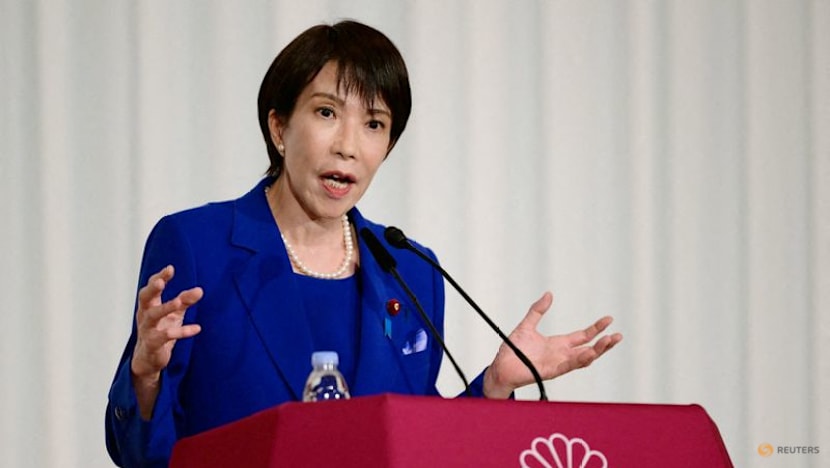Japan’s potential first female PM Sanae Takaichi faces test on economy, diplomacy: Observers
Takaichi was elected as the ruling party's new leader after a tightly contested race, putting her on track to become Japan’s first female prime minister — if she secures victory in a parliamentary vote next week.


This audio is generated by an AI tool.
Sanae Takaichi’s election as the first female leader of Japan’s ruling Liberal Democratic Party (LDP) marked a historic milestone, putting her on track to become Japan’s first female prime minister — if she secures victory in a parliamentary vote next Wednesday (Oct 14).
But analysts warned that she faces a tough road ahead, from mending foreign ties to rebuilding public trust at home.
The LDP elected Takaichi as its new president after a tightly contested race on Saturday.
The 64-year-old, a hardline conservative, succeeds outgoing Prime Minister Shigeru Ishiba as the party’s leader. Ishiba in September announced he was stepping down after the LDP suffered a string of election setbacks.
Takaichi’s immediate priorities are to restore economic confidence, manage Japan’s diplomatic relationships — particularly with the United States and China — and stabilise her own government, observers told CNA.
The LDP currently maintains power through its coalition with the smaller Komeito party. Although the alliance has lost its majority in both houses of parliament over the past year, it still holds the largest number of seats.
Takaichi will now need to secure a simple majority in next week’s special Diet session to be formally confirmed as prime minister.
William Pesek, a Tokyo-based journalist and columnist, stressed that while Takaichi is an experienced politician, her reputation for having “sharp elbows” could pose challenges as she seeks to build alliances.
“She's at a moment where she has to basically mend fences and win the support of opposition parties,” he added.
“A lot of these opposition parties want tax cuts in return for their support, and the one thing that could fall apart there would be her unwillingness to bend to their demands.
“(But) I think that the odds pretty much favour her being able to cobble together some kind of governing coalition and she will be prime minister.”
POLITICAL STABILITY AND FRAGILE MANDATE
Japan has long been known for its “revolving door” leadership, with a series of short-lived prime ministers cycling through office over the years — many lasting barely a year before being replaced.
One of Takaichi’s first challenges would be to simply remain in office for more than a year, Pesek told CNA’s Asia First programme.
“She'll have to work very, very hard to make sure that she's around for longer than 12 months, and at that point, she probably will have the latitude to make some reforms in the economy,” said Pesek, author of Japanization: What the World Can Learn from Japan's Lost Decades.
“But I think in many ways, one of her immediate challenges will be to put some wins on the board and stay around for more than 12 months. The easiest way to win support within the party, unfortunately, for better or worse, is to go after China.”
Seijiro Takeshita, professor of management and information at the University of Shizuoka, cautioned that if Japan continues its “revolving door” pattern of prime ministers, it will be difficult to push through meaningful structural reforms.
The veteran politician, who previously held several ministerial posts, is now considering whom to appoint to her Cabinet.
As the LDP no longer holds a majority in either house, Takaichi will need to secure support from other parties for almost every policy initiative she pursues, said Takeshita.
But Takeshita said his conversations with opposition MPs indicate a growing willingness to back policies based on substance rather than party lines.
“So from that point of view, maybe it's not as bad as many people think,” he added.
“But still, she would have to basically confirm and get a coalition on every single policy that they're trying to basically go forward with.”
The LDP has lost ground in recent elections, eroded by public anger over inflation and unpopular tax hikes.
“She needs to bring back more seats in the coming elections,” said Kotaro Tamura, adjunct professor at the Lee Kuan Yew School of Public Policy at the National University of Singapore.
“For that, she needs to listen to the people suffering from tax hikes and higher prices,” added Tamura, a former councillor and parliamentary minister for economic and fiscal policy in Japan.
Meanwhile, her win as LDP leader has been highlighted as a symbolic breakthrough in a country that ranks low on gender equality indices.
But analysts noted that Takaichi’s conservatism tempers expectations for gender progress.
She has long opposed legislation that would allow women to retain their maiden names after marriage, and supports maintaining the imperial family’s male-only line of succession.
While it is encouraging to see the glass ceiling finally shattered, whether she will actually advance gender equality “remains to be seen”, said Pesek.
ECONOMIC REVIVAL AND ABENOMICS
Pesek said many young Japanese are increasingly disillusioned by the sluggish economy and anxious about their future prospects.
Takaichi, who is a protege of the late former prime minister Shinzo Abe, has pledged to revive his signature “Abenomics” policies to boost the economy with aggressive spending and easy monetary policy.
Takeshita said what Japan’s economy needs most is a strong “jab in the arm” to spur growth — a challenge Takaichi appears eager to tackle.
He noted that despite Japan’s heavy public debt, she is pursuing expansionary fiscal policies to stimulate the economy.
The government debt is over 260 per cent of its gross domestic product — the highest such ratio among advanced economies.
Yet some economists argue that stimulating growth is more effective than immediate spending cuts for managing large public debt.
“I think from that point of view, I think she's making a very logical methodology by the books in order to revitalise Japan,” said Takeshita.
HAWKISH RHETORIC AND DIPLOMACY
Known for her hardline views on China, the staunch nationalist’s rise has raised questions about Japan’s future diplomacy.
Some observers said she is likely to tread carefully in the short term.
“She won’t provoke our neighbours unnecessarily … and will be in safe-driving mode,” Tamura said, adding that while Takaichi is likely to strike a conciliatory tone for now, she may adopt a tougher stance closer to elections to appeal to conservative voters.
But Pesek believes Takaichi’s reputation as a China hawk could shape her policy moves.
“I think one thing we're seeing is the LDP is having something of an identity crisis, and probably the easiest way for her to excite the LDP, the rank-and-file, is to be hard on China,” he added.
Her past visits to the controversial Yasukuni Shrine — which honours Japan’s war deaths, including war criminals — have also sparked criticism from China and South Korea, who see it as a symbol of the country’s wartime aggression.
Takaichi faces an early diplomatic test, with a visit from US President Donald Trump later this month.
“I think her most immediate challenge is Trump, Trump, Trump,” said Pesek, noting that Takaichi faces a delicate balancing act of managing Japan’s alliance with Washington without provoking Beijing.
The key question is whether she will pursue a more assertive approach by seeking to renegotiate trade terms with Washington - including tariffs of 15 per cent on the country’s exports to the US - or follow her mentor Abe’s more deferential style when dealing with its ally.
“I think it'll be a very difficult needle to thread,” Pesek said.
“That is a kind of wild card that nobody can explain at the moment.”

















